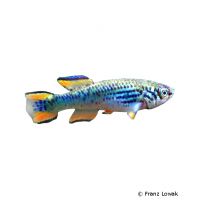Walker's Killi (Fundulopanchax walkeri)
| Walker's Killi Fundulopanchax walkeri | |
|---|---|
| Name | Walker's Killi |
| Name Lat. | Fundulopanchax walkeri |
| Synonym | Aphyosemion walkeri |
| Family | African Rivulines |
| Family lat. | Nothobranchiidae |
| Order | Killifishes & Livebearers |
| Order lat. | Cyprinodontiformes |
| Origin | Western Africa |
| Habitat | Streams |
| Diet | Carnivore |
| pH | 6.0-7.5 |
| Behavior | ♂ territorial |
| Keeping | Harem |
| Care Level | Moderate |
| Reproduction | Substrate spawner |
| Breeding | Moderately difficult |
| Life Span | 3-4 years |
| Protection | No |
| Metric Units | |
| Size | 7 cm |
| Temperature | 22-26 °C |
| Hardness | < 10 °dH |
| Aquarium | ~ 120 l |
| US Units | |
| Size | 2.8" |
| Temperature | 72-79 °F |
| Hardness | < 178 ppm |
| Aquarium | ~ 30 gal |
Distribution and habitat
The range of the Walker's splendid carps is waters in the wet savannas and coastal rainforests of eastern and western Côte d'Ivoire and southwestern Ghana. They live in weedy marshes and floodplains, in slow-moving streams, and in shallow bays of small rivers. There are numerous differently colored site varieties.
Maintenance
The aquarium should have dense planting, with hiding and retreat possibilities (roots) and provide sufficient swimming space. A soft, dark substrate covered with some foliage (e.g. sea almond leaves) and slightly shaded light (floating plants) is ideal
No ammonia, ammonium and nitrite should be detectable, the nitrate value should not exceed 100 mg/l. To ensure the water quality and oxygen content, a filter and heater adapted to the aquarium size is required, as well as lighting for the species-appropriate day-night rhythm of the animals.
Diet
In nature they feed mainly on insects and insect larvae. The food supply consists of live, frozen and dry food. For a balanced diet, feed once a day with a high-quality, protein-rich dry food (flakes, granules, micropellets) and with cyclops, moina, daphnia, artemia, mosquito larvae, etc. (live or frozen)
It is recommended to feed small portions several times a day. Only feed as much as will be eaten within a few minutes. A regular and varied diet promotes health and increases resistance.
Behaviour and compatibility
They should be kept in a harem, one male with 2-3 females. Males often behave aggressively among themselves, so keeping multiple harems is only recommended in a larger and richly structured tank. They can be kept well in a species tank or also in a community tank with not too lively fish, whereby too small fish are considered as food. Basically, only compatible fish species with similar demands on water condition and water temperature should be socialized.
Sex dimorphism
The male is much more colorful than the female.
Reproduction and breeding
They are bottom spawners. The female nestles close to the male and spawns directly on the bottom. The fry usually hatch after 14-28 days. However, the eggs can survive longer dry periods in the substrate. After 3-5 months, the fry hatch just a few hours after the first rain. Fry must be fed several times a day with special rearing food (Artemia nauplii, microworms). In a community tank breeding is hardly possible, because the spawn is easy prey.
Important
They occur as non-annual killifish that live in waters that hold water year-round, but also as annual species that live in waters that periodically dry up completely. This adaptation allows them to inhabit many habitats
Different site varieties or cultivated forms of Walkers splendor carps should not be maintained together, as they can interbreed (hybridize). They like to jump, so the aquarium should be well covered. Foliage (sea almond, oak, etc.) enriches the water with humic substances, naturally lowers the pH, and when decaying promotes the development of microorganisms that provide a valuable secondary food source. The well-being of the fish should be monitored regularly. Temperature should be checked daily, pH, hardness and nitrate levels at least every 14 days. Regular partial water changes are recommended, even when contaminant levels have not yet reached the upper limit. Sudden changes in water quality should be avoided. Newly introduced fish must be accustomed slowly to the water in the aquarium. Further literature can be found in your pet store.
References
Text: petdata; Image: Franz Lowak
Source: BMELV (1998): Tierschutzgutachten - Haltung von Zierfischen (Süßwasser); RIEHL & BAENSCH (2006): Aquarien Atlas Bd. 1, Mergus Verlag; RADDA & PÜRZL (1987): Colour Atlas of Cyprinodonts of the Rain Forests of Tropical Africa, Verlag Otto Hofmann; ENGELMANN (2005): Zootierhaltung - Tiere in menschlicher Obhut: Fische, Verlag Harri Deutsch
- Gemäß § 21 Abs. 5 Tierschutzgesetz idgF
